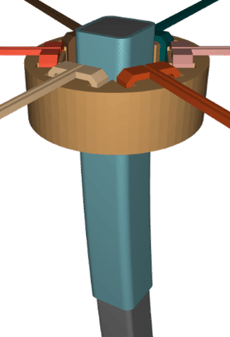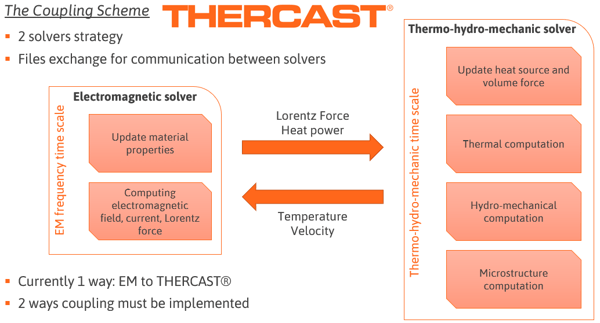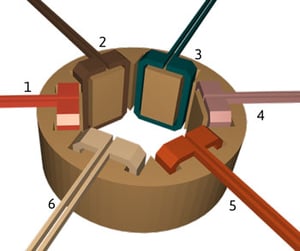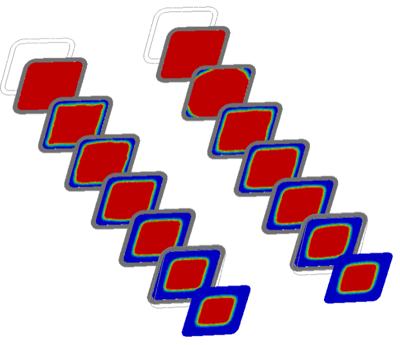Simulating electromagnetic stirring is avalaible with THERCAST®, our software dedicated to continuous casting, ingot casting and foundry processes.
What is electromagnetic stirring (EMS)?
 Electromagnetic stirring (EMS) is a process using a variable electromagnetic field to control conductive fluid flow without contact.
Electromagnetic stirring (EMS) is a process using a variable electromagnetic field to control conductive fluid flow without contact.
The magnetic field is produced by a stirrer that may be rotary, driving the fluid in rotation around the casting axis. It may also be linear and move the fluid along the wall.
EMS is frequently used in continuous casting for the multiple advantages it offers in terms of quality of the final part. Among other things, it serves to:
- Improve the quality of the part's surface
- Standardize skin thickness
- Increase casting speed
- Reduce defects, cracks and runout
- Reduce porosities and segregation
- Widen the equiaxed solidification structure
Why simulate electromagnetic stirring?
The position of the stirrers, or the strength of the magnetic field they produce, are parameters that are difficult to configure to achieve precise results. Thus, simulation serves to reduce the prototyping phase and to control the process more quickly, while limiting non-quality costs.
Electromagnetic stirring feature with THERCAST®
The THERCAST® simulation software can be used to:
- Define the geometry and location of the stirrers and their components (inducers, concentrators, core, etc.)
- Configure the supply current intensity, frequency and phase shift
- Control the flow rate of the metal
- Anticipate the location and progression of defects and segregations
- View Lorentz force fields
- Test different process or material configurations
The electromagnetic stirring feature is based on the coupling between two THERCAST® solvers: an electromagnetic solver and a thermo-hydro-mechanical solver, that exchange data relating to the process (Lorentz force, heat source, temperature, speed, etc.).

How the coupling between the two solvers works
To be able to simulate this process, it is necessary to perform a data setup for an electromagnetic stirring simulation and a continuous casting simulation. The sequencing between these two simulations is activated in a single click.
Case Study: continuous casting with electromagnetic stirring
The following example is based on a case of continuous casting.
The rotational electromagnetic stirrer is positioned close to the nozzle, at the top of the mold. It causes a rotating flowIt consists of six paired inducers, the current of each pair is phase-shifted by 120° relative to the others.
The analyses were carried out on comparative simulations with and without electromagnetic stirring. They aim to demonstrate the effect of stirring on metal flow and solidification.
Flow velocity
The velocity amplitude is displayed on a central cutting Plane (2D). In both case, the velocity at the nozzle outflow is very high. Without stirring, it decreases rapidly as it descends towards the bottom of the mold. With stirring, the velocity zone is deeper and closer to the walls, i.e. close to the stirrer. The material is thus better mixed, widening its equiaxed zone. The impact of the fluid on walls in reduced.
The velocity amplitude decreases faster without stirring (left) - than with stirring (right)
The same results are shown with volume vectors (3D). This modeling shows that, without stirring, the flow of metal impacts the walls, which instantly decreases the velocity field. With stirring, the vectors highlight the rotational flow of the metal.
Speed of the rotational flow with 3D volume vectors without stirring (left) - with stirring (right)
Metal solidification
The liquid fraction is observed on the first half of the mold. When stirring is activated, solidification begins lower in the mold than when it is deactivated. Most importantly however, the simulation shows that the thickness of the solidified skin is smoother. Consequently, the risk of cracking and rupture is minimized.
Change in skin smoothness without stirring (left) - with stirring> smoother (right)
This feature is integrated into the next major delivery of THERCAST® and is compatible with other features already available such as self-radiation, segregation analysis, TTT diagrams, etc.

Change in skin solidification without stirring (left) - with stirring (right)
This feature is integrated into the next major delivery of THERCAST® and is compatible with other features already available such as self-radiation, segregation analysis, TTT diagrams, etc.
Conference: simulation of Electromagntic stirring
During the Transvalor International Simulation Days 2022, Grégory Puaux (Software Development Engineer), presented the electromagnetic stirring feature of our THERCAST® software on a continuous casting case.





